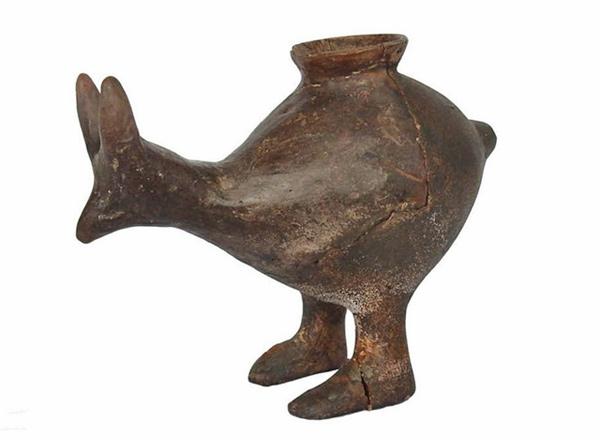You are here
Babies have been drinking milk from bottles for thousands of years
By Los Angeles Times (TNS) - Sep 28,2019 - Last updated at Sep 28,2019

A late Bronze Age feeding vessel from Vosendorf, Austria, dating from about 1,200 to 800 BC (Photo courtesy of Katharina Rebay-Salisbury/TNS)
By Deborah Netburn
The vessels are small and ceramic. Some resemble tiny teapots, others look like small pipes, and a few are sculpted into whimsical animal shapes with a little spout on the backside.
When they were discovered in ancient cemeteries scattered across Europe, some archaeologists wondered if they were used to feed the sick or the elderly. But because they were often buried in graves alongside infants, most experts agreed that the vessels likely served a different purpose entirely:
Call them prehistoric baby bottles.
Now, a new chemical analysis of three of these ancient containers provides further evidence that the vessels were indeed used to feed milk from cows, sheep or goats to human babies.
“People have known about these containers for a long time and assumed they were baby bottles, but nobody had done a thorough analysis on them,” said Julie Dunne, a chemist at the University of Bristol in England, who led the work. “What I liked about this study is that it gave us a nice, close connection to parents of the past.”
Dunne works in the university’s Organic Geochemistry Unit, a research group that has chemically analysed roughly 10,000 shards of pottery from around the world to help archaeologists better understand what foods and other materials the artefacts once contained.
Their work has revealed that lipids, the building blocks of fats, can survive for thousands of years.
“What we know from years of experimental work is that fats absorb into the ceramic matrix of the vessel and are often preserved there,” Dunne said. “Because of that, lipids do survive in about 80 per cent of the assemblages we’ve looked at.”
In the new study, Dunne and her colleagues collected samples from three ceramic baby bottles that had been found next to infants in ancient German burial sites. Two of the bottles came from a cemetery complex that scientists believe was in use between 800 and 450 BC; the other bottle was found in a site dated to 1200 to 800 BC. (The earliest-known ceramic baby bottles have been dated to about 5,000 BC.
The researchers had been looking for vessels that had wide openings, so they would be easier to work with. Still, Dunne said that collecting samples from the bottles was a nerve-racking experience.
Usually, her team begins its analysis by grinding up pieces of old cooking pots. But since the small bottles were still intact, that was not an option.
“We had to adopt a modified strategy,” she said.
They cleaned the interior surfaces of the vessels, then drilled out just enough ceramic powder to be able to see any lipids that had been absorbed by the pottery. Next, they used a chemical process to free the lipids from the ceramic matrix, allowing them to measure the chemical and isotopic fingerprint of each one.
Ultimately, they found that the vessels contained fatty acids from dairy products — almost certainly milk — that came from domesticated ruminant animals, according to their report in the journal Nature. They were not able to tell if the milk came from cows, sheep or goats.
The work represents “the earliest known evidence of animal milk in small bottles for infants,” Sin Halcrow, a bioarchaeologist at the University of Otago in New Zealand, wrote in an essay accompanying the paper.
Halcrow, who was not involved in the study, added that the work also “provides crucial insight into the diet of developing infants in prehistoric human populations”.
Dunne said she hopes the new work will lead to a much larger study that will apply the same kinds of analytic tools to ceramic baby bottles across a larger geographical area.
“We know the ancient Greeks were using similar vessels, also the Romans, and some have been found in prehistoric Sudan in north Africa,” she said. “It would be fantastic to do a really large-scale study to see if they are always used to hold milk or if they had other foods processed in them.”
The authors noted that while breast milk has always been integral to infant care across history and cultures, there is considerable variation among human societies as to when new foods are introduced and how long a child continues to get nutrition directly from mom.
For example, archaeologists have found that hunter-gatherers typically breastfed for several years, whereas the more sedentary lifestyle of early farming communities allowed mothers to stop nursing earlier because other foods were more readily available.
It is possible that this shorter weaning period may also have led to shorter birth intervals between children, the authors wrote. That, in turn, could have contributed to the considerable growth in population known as the Neolithic demographic transition.
Dunne and her fellow researchers were curious to see how a modern-day infant would respond to a replica of one of the ancient bottles, so they recruited the baby of one of their friends.
The rounded shape of the prehistoric bottle fit perfectly in the young child’s hands. The scientists poured in some milk and tipped a bit of it into the baby’s mouth. The baby quickly started sucking the spout to get a bigger drink.
The ancient baby bottle technology still worked.
Related Articles
AMMAN — Middle Islamic pottery is an understudied subject and until recently no comprehensive typology existed for pottery from this p
Babies who consume nothing but breast milk for their first three months of life may have healthier cholesterol levels by adolescence than in
PARIS — Humans have hankered after chocolate for centuries longer than previously thought, scientists said on Monday, tracing the earliest k



















